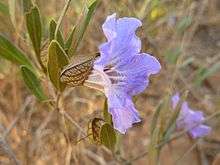Petalidium
| Petal-bushes | |
|---|---|
 | |
| P. oblongifolium flower with veined, cuspate bracteoles | |
| Scientific classification | |
| Kingdom: | Plantae |
| (unranked): | Angiosperms |
| (unranked): | Eudicots |
| (unranked): | Asterids |
| Order: | Lamiales |
| Family: | Acanthaceae |
| Genus: | Petalidium Nees |
Petalidium, commonly known as petal-bushes, is a genus of perennial shrubs in the acanthus family.[1] They are native to sandy flats or stony slopes in the drier bush regions of Africa, India and the Mascarene Islands.[2] The majority of species occur in frost-free, summer rainfall regions of southern Africa,[3] and may be found from low to medium altitudes.
Description
They have a diverse habit, forming either small, scrambling herbs or large, robust shrubs.[3] Their dilated, tubular flowers are solitary or on short racemes growing from the leaf axils, and vary from white to mauve or red in colour. The four stamens are partially fused with the corolla, and the style is branched into two unequal parts. The calyx is deeply divided into five segments.[2]
Two large, ovate to elliptic bracteoles subtend and protect the young corolla.[2] The persistent bracteoles may be conspicuously veined or covered by long, villous trichomes. The small, ellipsoid fruit capsules explosively release two to four flat seeds (two ovules per ovary cell) when moisture is absorbed by their hygroscopic hairs.[1] Young foliage and branches are covered in gland-tipped hairs. The leaves are entire.[2]
Cultivation
Some species are cultivated as ornamentals, as they grow fast and flower profusely.
Etymology
According to Jackson (1990),[4] the name Petalidium is derived from the Greek petalon (a leaf or petal), which may refer to the deciduous, leaf-like bracts, while bracteatum likewise refers to the large, imbricate (i.e. overlapping) bracts.[1]
Species
There are more than 30 species in all,[5] of which 29 occur in southern Africa.[6] The species include:
- Petalidium angustitubum P.G. Mey.
- Petalidium aromaticum Oberm. – n South Africa, s Zimbabwe[7]
- Petalidium barlerioides (Roth) Nees
- Petalidium bracteatum Oberm. – s Angola?, n & c Namibia[1]
- Petalidium canescens C.B. Clarke
- Petalidium cirrhiferum S.Moore
- Petalidium coccineum S.Moore – nw Namibia[3]
- Petalidium crispum A. Meeuse ex P.G. Mey.
- Petalidium currorii S.Moore – Angola[2]
- Petalidium cymbiforme Schinz
- Petalidium giessii P.G. Mey.
- Petalidium glandulosum S.Moore
- Petalidium gossweileri S.Moore
- Petalidium halimoides (Nees) S.Moore – Namibia
- Petalidium oblongifolium C.B. Clarke – South Africa
- Petalidium ohopohense P.G. Mey.
- Petalidium physaloides S.Moore – Namibia[8]
- Petalidium pilosi-bracteolatum Merxm. & Hainz – Namibia[8]
- Petalidium ramulosum Schinz
- Petalidium rautanenii Schinz
- Petalidium rossmannianum P.G. Mey.
- Petalidium rupestre S.Moore
- Petalidium setosum C.B. Clarke ex Schinz – n, c & s Namibia[8][9]
- Petalidium spiniferum C.B.Clarke – Chella Mountains, Angola[10]
- Petalidium subcrispum P.G. Mey.
- Petalidium tomentosum S.Moore
- Petalidium variabile C. B. Cl. Hybrid
- Petalidium welwitschii S.Moore
References
- 1 2 3 4 van Jaarsveld, Ernst. "Petalidium bracteatum Oberm.". plantzafrica. Kirstenbosch NBG, SANBI. Retrieved 23 June 2015.
- 1 2 3 4 5 Clarke, C. B. (1912). "Petalidium Nees". Flora Capensis, Kew Gardens. 5: 1. Retrieved 24 June 2015.
- 1 2 3 van Jaarsveld, Ernst. "Petalidium coccineum S.Moore". plantzafrica. Kirstenbosch NBG, SANBI. Retrieved 23 June 2015.
- ↑ Jackson, W. P. U. (1990). "Origins and meanings of names of southern African plant genera". Ecolab, Botany Department, University of Cape Town.
- ↑ "Petalidium". The Plant List (2013). Version 1.1. Retrieved 23 June 2015.
- ↑ Germishuizen, G.; Meyer, N. L. (2003). "Plants of southern Africa: An annotated checklist". Strelitzia. 14: 1–1231. Retrieved 23 June 2015.
- ↑ Hyde, M.; et al. "Petalidium aromaticum Oberm. var. aromaticum". Flora of Zimbabwe. Retrieved 24 June 2015.
- 1 2 3 "Petalidium pilosi-bracteolatum Merxm. & Hainz". Kyffhäuser flora. Retrieved 24 June 2015.
- ↑ Tripp, Erin. "Petalidium setosum". The Tripp Report. Retrieved 24 June 2015.
- ↑ "PETALIDIUM spiniferum C. B. Clarke [family ACANTHACEAE]". Global Plants. JSTOR. Retrieved 23 June 2015.
External links
- Petalidium Nees, Flora of Tropical Africa, Kew, Global Plants